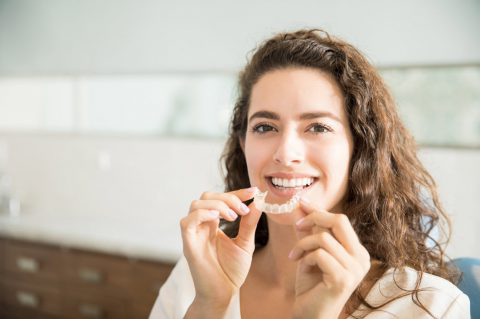
Braces – they aren’t just for teenagers anymore. And it seems like there has been a flood of new options being advertised recently. You’ve likely heard of Invisalign. You’ve likely seen the ads for teeth straightening products you can send away for through the mail, You’ve definitely seen traditional metal braces on countless teens, pre-teens, and even adults. With so many options, how do you know which one is best? We’re here to help! Here’s the low down about your options when it comes to braces.
What is Invisalign?
Invisalign is an orthodontic system that uses clear, removable, aligners to straighten teeth. The biggest appeal of Invisalign is that they are discreet, making them perfect for adults and active teens. Not only are they more discreet, they also allow you to keep eating your favorite foods, to stay active in the sports and activities you enjoy and they make it easier to care for your teeth during orthodontic treatment.
What are Traditional Braces?
Traditional braces are the metal brackets and wires that come to mind when talking about orthodontics. The brackets are cemented to the teeth and the wire is adjusted to encourage the movement of the teeth. While often referred to as “metal” braces, there are also ceramic braces that are tooth colored and more discreet than traditional silver metal brackets that offer the same durability, strength and effectiveness as their metal counterparts.
Invisalign vs Metal Braces
Ultimately, the goal of all orthodontic treatment is to help you achieve optimal oral health. Straightening teeth is more than just looking good, crooked teeth and misaligned bites can impact not only how you feel about yourself, but can also impact your speech, your ability to chew and the function of your jaw. While both traditional metal braces and Invisalign help straighten teeth, one option will often be preferred by your dentist.
To determine if traditional braces or Invisalign is best for you, the dentist will look at:
- If teeth need to be removed
- If you already have missing teeth
- The severity of your crowding or misalignment of your teeth
- The size and shape of your jaws
- Whether or not you have issues with your bite
- Oral hygiene habits
- Presence of tooth decay and/or gum disease
- Age/Maturity of patient
- Budget
- Length of time needed
- Lifestyle

All of these factors will lead the dentist or orthodontist to suggest the right type of treatment for you. And, working with a dental professional will not only help you choose well, they will be there every step of the way to ensure safety, health, and a successful outcome.
- Tags:
- Metal Braces